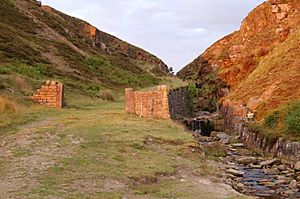Black Brook (Chorley) facts for kids
Black Brook is a small river located in Lancashire, England. It begins high up on Great Hill in the West Pennine Moors. The water in Black Brook often looks brown. This is because it flows through areas with a lot of peat. Peat is a type of soil made from decayed plants. It makes the water slightly acidic and gives it a brownish tint.
Long ago, when it was a younger stream in Heapey, it was called Warth Brook. Another small stream, also named Black Brook, joins it near Kittiwake Road. This combined stream then flows into Anglezarke Reservoir. Finally, Black Brook meets the River Yarrow in Chorley at a place called Yarrow Bridge. The entire journey of Black Brook and the River Yarrow happens within Chorley and its nearby villages.
The History of Black Brook's Power
For many years, Black Brook was an important source of power. It drove a water mill at Leicester Mill, located in White Coppice. This mill used the force of the flowing water to turn its machinery. The nearby Leicester Mill Quarries were named after this very mill. This shows how important the brook was to the local industries in the past.
Wildlife Returns to Black Brook
For a long time, Black Brook suffered from serious pollution. Factories like Whitter's and Stanley's used to release waste into the water. This made it difficult for plants and animals to live there.
However, things have changed. The river is now much cleaner thanks to efforts to stop pollution. This improvement has brought back many different kinds of wildlife.
You can now spot beautiful birds along the brook's banks. These include the dipper, which bobs up and down on rocks, the grey wagtail with its long tail, and the bright kingfisher. Fish have also returned to the clearer waters. You might find trout, chub, dace, and barbel swimming in Black Brook once more. This shows how nature can recover when we protect our rivers.


